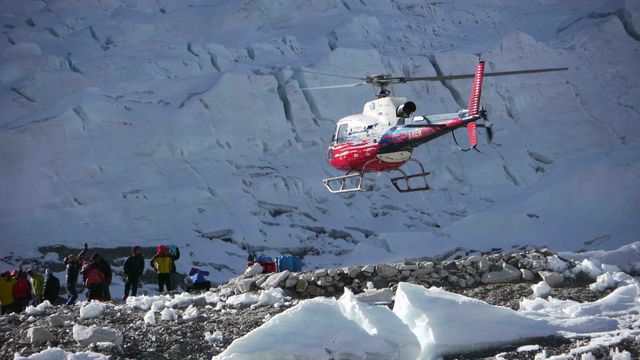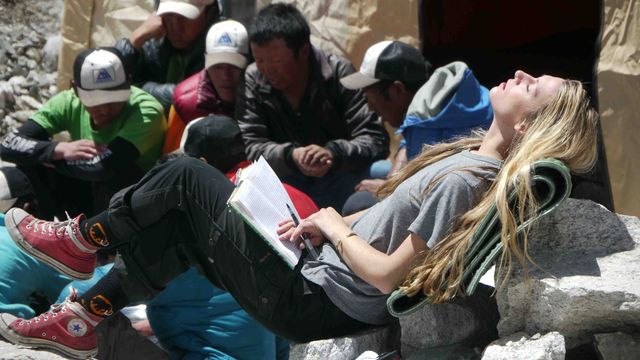
APRIL 26
This morning I awoke at 7:20 a.m. to the rotors of the latest model Eurocopter B3 hovering above my tent as it prepared to land 50 yards away to resupply a neighboring camp. I thought to myself, this is getting a little surreal, as I walked from my personal tent to our dining tent for my morning cup of coffee. As I strolled over the rocky moraine of our base camp with java on my mind, I heard what sounded like a swarm of angry mosquitos approaching, and then saw the small 6 rotor drones flying about filming the tents of our camp below. I first saw this drone on the trek in at Phakding when its Chinese owners were staying in the same lodge as us, and they explained to me that the contraption they would disassemble and carry by hand cost well over $100,000.
Over the last few years, as the Eurocopter B3 proved very adept at flying at high altitudes, it became a popular way for climbers to quickly exit locations such as Everest base camp (17,500’), in the event of an injury or illness that was life threatening. But of course it also allowed for healthy climbers to shell out a few thousand bucks and avoid the mult-day trek from base camp to Lukla and then fly out on a twin otter from the world’s most dangerous runway. Last year a few of my climbers flew out of Base Camp after a successful climb by helicopter to Kathmandu and were home in Dubai that same day.
These helicopters have proved very efficient at evacuating injured or ill climbers, but they also have opened up a new dimension of commerce on 8000-meter peaks that previously did not exist. Watching this burgeoning industry evolve with little to no regulation is exciting. The established helipad just below Base Camp that was supposed to be reserved for medical evacuations is regularly used for non- emergency flights. Daily sightseeing tours with tourists from Kathmandu hover over Base Camp just a few hundred meters off the deck. And the Nepali team next to ours recently built their own helipad so that they could easily resupply their camp with fresh food and ferry members in and out of camp regularly. When the helicopter lands, people walk around the impressive machine and snap photos or shoot movie clips to upload to their Facebook pages. Back home in the U.S. when I have been around helicopters the pilot and other crews are militant about keeping people away from the tail rotors that would chop a person apart. But not here in Nepal, where helicopter flights mean thousands of dollars in cash changing hands. There are now 4 commercial helicopter companies here competing for passengers' dollars, and the prices for flights varies widely.
Having traveled halfway around the world and trekked 2 weeks to reach Everest Base Camp, I am a little disappointed that I awake to the deafening roar of thumping rotors above my tent and then the buzz of a mini drone helicopter as I enjoy my morning coffee and the views of Everest, Nuptse, & Pumori (peaks surrounding Base Camp). But then again, this is not about solitude in nature: there are over a thousand people in camp, and those aiming to climb to the top of the highest mountain in the world have brought with them satellite modems to access the internet, movie projectors to watch films in the evenings (and generators to keep those projectors going well after dark), and even gourmet food and western chefs to satisfy their palates. This is about going big, reaching the highest point on earth, and having a great time along the way.

Do I resent this development of Base Camp into a mini city, with high-tech aircraft, high-speed Wi-Fi, eggs benedict, carpeted leisure tents with propane heaters, etc.? Honestly I think it is all pretty nice considering I am “on the job.” If I were to break my leg up on the Lhotse Face, I would prefer the helicopter ride from the base of the face at 22,000’ direct to Kathmandu rather than be carried down the Western CWM and the Khumbu Icefall on the backs of Sherpas, then strapped to a Yak in base camp for the multi day ride down to Lukla. And the luxuries I have access to in my camp such as Wi-Fi, our lovely and skilled chef Alexandra … these amenities I prefer to the hundreds of mountain climbing expeditions where I cooked instant oatmeal for my clients and had zero communication with the outside world. Considering I am working as I guide clients to the top of the world, I might as well ask for a base camp masseuse next year to take care of us poor climbers between our forays up the mountain.

APRIL 26
This morning I awoke at 7:20 a.m. to the rotors of the latest model Eurocopter B3 hovering above my tent as it prepared to land 50 yards away to resupply a neighboring camp. I thought to myself, this is getting a little surreal, as I walked from my personal tent to our dining tent for my morning cup of coffee. As I strolled over the rocky moraine of our base camp with java on my mind, I heard what sounded like a swarm of angry mosquitos approaching, and then saw the small 6 rotor drones flying about filming the tents of our camp below. I first saw this drone on the trek in at Phakding when its Chinese owners were staying in the same lodge as us, and they explained to me that the contraption they would disassemble and carry by hand cost well over $100,000.
Over the last few years, as the Eurocopter B3 proved very adept at flying at high altitudes, it became a popular way for climbers to quickly exit locations such as Everest base camp (17,500’), in the event of an injury or illness that was life threatening. But of course it also allowed for healthy climbers to shell out a few thousand bucks and avoid the mult-day trek from base camp to Lukla and then fly out on a twin otter from the world’s most dangerous runway. Last year a few of my climbers flew out of Base Camp after a successful climb by helicopter to Kathmandu and were home in Dubai that same day.
These helicopters have proved very efficient at evacuating injured or ill climbers, but they also have opened up a new dimension of commerce on 8000-meter peaks that previously did not exist. Watching this burgeoning industry evolve with little to no regulation is exciting. The established helipad just below Base Camp that was supposed to be reserved for medical evacuations is regularly used for non- emergency flights. Daily sightseeing tours with tourists from Kathmandu hover over Base Camp just a few hundred meters off the deck. And the Nepali team next to ours recently built their own helipad so that they could easily resupply their camp with fresh food and ferry members in and out of camp regularly. When the helicopter lands, people walk around the impressive machine and snap photos or shoot movie clips to upload to their Facebook pages. Back home in the U.S. when I have been around helicopters the pilot and other crews are militant about keeping people away from the tail rotors that would chop a person apart. But not here in Nepal, where helicopter flights mean thousands of dollars in cash changing hands. There are now 4 commercial helicopter companies here competing for passengers’ dollars, and the prices for flights varies widely.
Having traveled halfway around the world and trekked 2 weeks to reach Everest Base Camp, I am a little disappointed that I awake to the deafening roar of thumping rotors above my tent and then the buzz of a mini drone helicopter as I enjoy my morning coffee and the views of Everest, Nuptse, & Pumori (peaks surrounding Base Camp). But then again, this is not about solitude in nature: there are over a thousand people in camp, and those aiming to climb to the top of the highest mountain in the world have brought with them satellite modems to access the internet, movie projectors to watch films in the evenings (and generators to keep those projectors going well after dark), and even gourmet food and western chefs to satisfy their palates. This is about going big, reaching the highest point on earth, and having a great time along the way.

Do I resent this development of Base Camp into a mini city, with high-tech aircraft, high-speed Wi-Fi, eggs benedict, carpeted leisure tents with propane heaters, etc.? Honestly I think it is all pretty nice considering I am “on the job.” If I were to break my leg up on the Lhotse Face, I would prefer the helicopter ride from the base of the face at 22,000’ direct to Kathmandu rather than be carried down the Western CWM and the Khumbu Icefall on the backs of Sherpas, then strapped to a Yak in base camp for the multi day ride down to Lukla. And the luxuries I have access to in my camp such as Wi-Fi, our lovely and skilled chef Alexandra … these amenities I prefer to the hundreds of mountain climbing expeditions where I cooked instant oatmeal for my clients and had zero communication with the outside world. Considering I am working as I guide clients to the top of the world, I might as well ask for a base camp masseuse next year to take care of us poor climbers between our forays up the mountain.